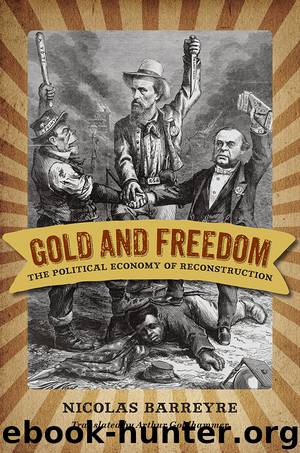Gold and Freedom by Barreyre Nicolas;

Author:Barreyre, Nicolas;
Language: eng
Format: epub
Publisher: Lightning Source Inc. (Tier 3)
FIGURE 7. Chronology of major congressional debates, 1869–70
Sherman’s call for a pragmatic approach went largely unheeded, however. His colleagues stuck to principled positions that had hardened over five years of controversy. The sectional confrontation was harsher than ever, especially because the issue was now being debated all across the country. Senator Timothy O. Howe of Wisconsin complained that “a popular lecturer has recently assured the South and West that they need no more circulation. But, sir, it takes a very ingenious physician to persuade a man who is fainting from exhaustion that there is nothing the matter with him.” The presence of Southerners in Congress strengthened the position of the Midwest. Frederick A. Sawyer, a Republican from South Carolina, castigated his colleagues from the Northeast for defending their section’s virtual monopoly on national banks, a business that had “proved one of the most profitable” in the country and thus placed “the rest of the country in a condition where every single transaction which occurs must pay tribute to the monetary power centered there.”46 The voting on the bill to reallocate national banking capital reflected a particularly acute sectional polarization, which divided both parties.47 The different political complexions of the Senate and House—the former more conservative than the latter—made compromise difficult. It took two conference committees to achieve a very modest result. The Northeast made only minor concessions: some $25 million in national banking capital was reallocated to the Midwest and South (out of a total of $318 million), and a new issue of $54 million was approved.48 Norman B. Judd, the Chicago representative who initiated the fight over reapportionment in the House, judged “half a loaf [better] than no bread” and was happy “that Congress shall declare now, without further agitation, that they will proceed in the direction of justice and equity.”49
The same logic governed the adoption of the second measure, which dealt with funding the debt. Seventy-five percent of it consisted of five-twenties on which the government paid six percent annual interest. Since these bonds could be called after five years, the idea was to exchange them for new Treasury bonds paying a lower rate of interest, which would reduce the amount the government had to pay out in gold. Boutwell and Sherman proposed to authorize the issue of bonds of 10, 15, and 30 years yielding, respectively, 5, 4.5, and 4 percent. Although this move seemed advantageous to the government, it touched the hard-earned compromise on Public Credit Act. Benjamin F. Butler rose to denounce the attempt in the House: “Against the people you promised, a year ago last March, to pay these five-twenty bonds in coin, when the contract did not call for coin. But you said you would not pay them in coin until you could also pay the people’s currency, the greenbacks, in coin.” The Public Credit Act had confirmed the link between the public debt and paper money. The proposal to amend it instantly revived sectional tensions. “I say here, in behalf of my
Download
This site does not store any files on its server. We only index and link to content provided by other sites. Please contact the content providers to delete copyright contents if any and email us, we'll remove relevant links or contents immediately.
The Secret History by Donna Tartt(18412)
The Social Justice Warrior Handbook by Lisa De Pasquale(12008)
Thirteen Reasons Why by Jay Asher(8565)
This Is How You Lose Her by Junot Diaz(6553)
Weapons of Math Destruction by Cathy O'Neil(5947)
Zero to One by Peter Thiel(5556)
Beartown by Fredrik Backman(5429)
The Myth of the Strong Leader by Archie Brown(5296)
The Fire Next Time by James Baldwin(5090)
How Democracies Die by Steven Levitsky & Daniel Ziblatt(5018)
Promise Me, Dad by Joe Biden(4963)
Stone's Rules by Roger Stone(4925)
100 Deadly Skills by Clint Emerson(4744)
A Higher Loyalty: Truth, Lies, and Leadership by James Comey(4651)
Rise and Kill First by Ronen Bergman(4590)
Secrecy World by Jake Bernstein(4482)
The David Icke Guide to the Global Conspiracy (and how to end it) by David Icke(4468)
The Farm by Tom Rob Smith(4364)
The Doomsday Machine by Daniel Ellsberg(4300)
